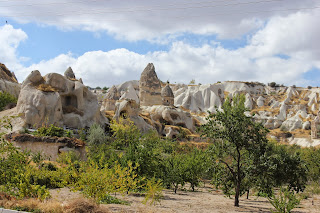We set out on the roadtrip (most of it by bus) on the night of Day 3.
Most of our bus travel was through the nights, making it efficient time wise as well as cost wise. If you want to do these places, be ready to traverse 600-700 kms by road, and between 8 to 13 hours of bus journeys. Neeta, in all her diligent research before the trip had also checked out the railways. But as they were then undergoing renovations on our route, we chose to take the next cheapest option.
We found bus travel in Turkey to be pleasant and safe. There was a uniformed steward in every bus, complete with tie and crisp white shirt. That they doled out complimentary juice, water and some delicious cake with chocolate filling increased the pleasantness quotient multi-fold. It is likely that the cakes get distributed in the middle of the night, so leave instructions with the attendant to wake you up / keep it aside for you as those supplies can be limited :)
Generally speaking, all public toilets in Turkey are clean - so every Lira you've gotta shell out for a pee is quite worth it.
Cappadocia, in the Anatolia region of central Turkey, was where we were headed first. Because it is nestled this much in the center of the country, a lot of tourists give it a pass. We met with a lot of cruise liner tourists who either made it to Istanbul....or came in to Kusadasi and Ephesus from the Aegean Sea....and got out of Turkey.
Giving Cappadocia a miss is not a good idea. Rich in its peculiar landscape and history, this area here has been formed over 60 million years of volcanic eruptions ((Mount Erciyes being the big one among three volcanos) that covered the plateau with layers of ash, lava, basalt and soft rock called tuff. Earthquakes and ongoing effects of erosion from wind, snow, rain have contributed to form the unique landscape that can be seen today - miles of cliffs and valleys in beautiful shapes and colours. Some of them are known as "fairy chimneys" where only the basalt lava stayed on the top, and the rain and snow and wind eroded the rock below.
The very soft rock also rendered it easy for early inhabitants to create caves with even primitive tools. Communities took advantage of this to make their home in the rock and under the ground. Which means some of what we see here are evidences of some very old human civilizations and their homes, churches and whole cities!
There are not too many buses that ply the Istanbul to Goreme route. Goreme Tours, Metro Tours, Cappadocia Tours are some of them. When doing bus travel in Turkey, and especially to the Cappadocia region - Make sure you know where the bus is going to drop you off. Some tourists have posted online about how they have been dropped off at Nevsehir with the assurance that there will be a shuttle from there to Goreme (or Urgup, another favourite tourist destination in this region), only to find upon reaching there that either they have to either fend for themselves or the shuttle is many hours away. We almost saw this happening ourselves. So check and double-check on this at the time of booking your tickets.
We reached Nevsehir early in the morning after a surprisingly fitful night of sleep. You start to really get a sense of "Cappadocia" only about 1 hour into your drive from Nevsehir..up until then you are mostly met with golden barren landscape, scantily interspersed with squares of grapevines.
Then they start peeking up...the odd-shaped hills...the "fairy chimneys"! Our bus took a few turns around the hills, and we were suddenly surrounded by the unique landscape everywhere in Goreme, a quaint little village. Most of the village has its homes and hotels built right into the caves and thereby its inhabitants are cave-dwellers...now that's what I'd call that unique!
 |
| A few turns around the hills and we were welcomed by the sight of houses carved right into the rocks, many of which are still inhabited. |
 |
| Some of the caves are reminders of earlier inhabitants who made their homes, burial grounds here. Some just continue to be lived in...and with a chimney (and not just of the fairy kind)! :) |





No comments:
Post a Comment